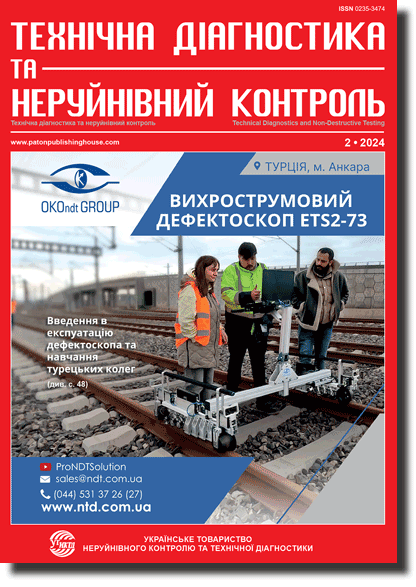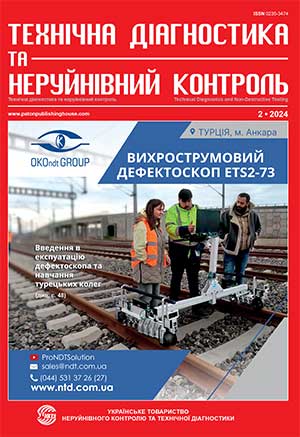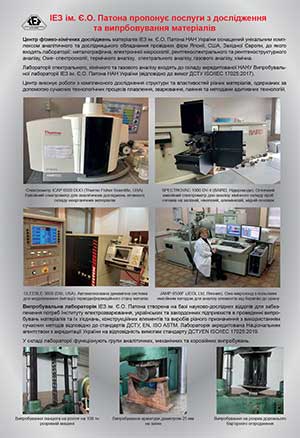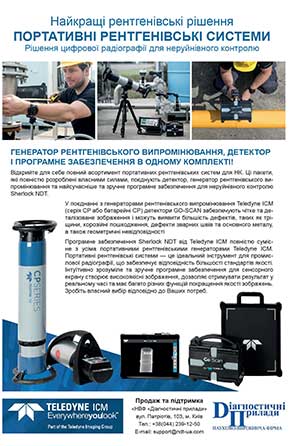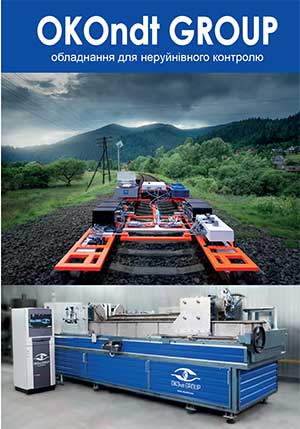| 2024 №02 (04) |
DOI of Article 10.37434/tdnk2024.02.05 |
2024 №02 (06) |

"Tekhnichna Diahnostyka ta Neruinivnyi Kontrol" (Technical Diagnostics and Non-Destructive Testing) #2, 2024, pp. 34-40
Detection of fatigue cracks in the fillet zone of steel blades of industrial gas turbines using EDDY current method
V.M. Uchanin1, D. Nardoni2, P. Nardoni2
1G.V. Karpenko Physico-Mechanical Institute of NASU. 5 Naukova str., 79060, Lviv, Ukraine. E-mail: vuchanin@gmail.com2I&T Nardoni Institute, Via della Cascina Pontevica, 21, 25124, Brescia, Italy. E-mail: nardoni.campus@gmail.com
The results of experimental investigations needed for the development of an effective eddy current technique for detection of the fatigue cracks originated in the critical fillet zone of gas turbine blades from ferromagnetic steels are discussed. The proposed inspection technique is based on using selective eddy current probes of double-differential type, which can ensure a high sensitivity when the clearance between the probe operational surface and the blade surface in the fillet zone is changed during the scanning. Experimental investigation of signals of eddy current probe of MDF 0501 type (operational surface diameter of 5 mm) allowed minimizing the lift-off influence by selecting the optimal operating frequency and the scanning parameters of the inspected zone. The proposed technique effectiveness was confirmed with the application for a real gas turbine blade with a 2 mm long and 0.2 mm deep artificial defect in the fillet zone, which characterizes the sensitivity threshold in accordance with the technical assignment. The developed technique has been used with success also during its trials in the power industry plants. 20 Ref., 9 Fig.
Keywords: gas turbine blade, fillet zone, eddy current probe, operation frequency
Received: 11.04.2024
Received in revised form: 10.05.2024
Accepted: 12.06.2024
References
1. Benini, E. (Ed) (2011) Advances in gas turbine technology. InTech, Rijeka, Croatia. www.intechopen.com. https://doi.org/10.5772/6642. Mane, S. (2023) Advancements in gas turbine engine technology: A conceptual aspect. Inter. J. of Enhanced Reseach in Science, Technology & Engineering, 12(7), 37-41. DOI: https://doi.org/10.55948/IJERSTE.2023.0706
3. Subbotovich, V.P., Yudin, Yu.A., Yudin A.Yu., Boyarchinov, A.Yu. (2013) Examination of near-root zone of turbine blade. Visnyk KhPI, Series Power and Heat Engineering Processes and Equipment, 13(987), 34-37 [in Russian].
4. Sameezadeh, M., Farhangi, H. (2012) Fracture analyzes of generator fan blades. Applied Fracture Mechanics, Rijeka, InTech, 311-330. www.intechopen.com. https://doi.org/10.5772/54122
5. Rajabinezhad, M., Bahrami, A., Mousavinia, M., Seyedi, S., Taheri, P. (2020) Corrosion-fFatigue failure of gas-turbine blades in an oil and gas production plant. Materials, 13(4), 900. https://doi.org/10.3390/ma13040900
6. Abassi, W., Rahman, S., Metala M. (2008) NDE techniques and lifetime assessment of turbine equipment. Power-Gen International, Orlando Florida.
7. Pitkänen, J., Hakkarainen, T., Jeskanen, H. et al. (2000) NDT methods for revealing anomalies and defects in gas turbine blades. 15th World Conf. on Non-Destructive Testing, Rome. www.ndt.net.
8. Abassi, W., Fair, M. (2006) Ultrasonic phased array inspection of turbine components. 9th European Conf. on Non-Destructive Testing, Berlin. www.ndt.net.
9. Libby, H. (1971) Introduction to electromagnetic nondestructive test methods, 1st ed. Wiley-Interscience, New York, NY, USA.
10. Udpa, S.S., More, P.O. (Eds) (2004) Nondestructive testing handbook (third edition). Vol. 5, Electromagnetic testing, American Society for NDT.
11. Garcíamartín, J., Gómezgil, J., Vázquezsánchez, E. (2011) Non-destructive techniques based on eddy current testing. Sensors, 11, 2525-2565. https://doi.org/10.3390/s110302525
12. Helifa, В., Oulhadj, A., Benbelghit, A., Lefkaier, I., F. Boubenider F., Boutassouna D. (2006) Detection and measurement of surface cracks in ferromagnetic materials using eddy current testing. NDT&E International, 39, 384-390. https://doi.org/10.1016/j.ndteint.2005.11.004
13. Jansen, H. (2012) Eddy current testing: profiled eddy current probes for complex shape iInspection. 18th World Conf. on Non-Destructive Testing, Durban. www.ndt.net.
14. Nath, S. C., Batzinger, T. J., Rose, C. M., Plotnikov, Y. A., Herd, K. G. (2004) Method for in-situ eddy current inspection of coated components in turbine engines. US Patent № 6707297, G01N27/82, GE Company, publ. 16.03.2004.
15. Tian, G.Y., Sophian, A. (2005) Reduction of lift-off effects for pulsed eddy current NDT. NDT&E International, 38, 319-324. https://doi.org/10.1016/j.ndteint.2004.09.007
16. Kuts, Y., Lysenko, J., Dugin, A., Zakrevskii, A. (2016) Analysis of an eddy-current transducer with impulsive excitation in the nondestructive testing of cylindrical objects. Mater. Sci., 52(3), 431-437. https://doi.org/10.1007/s11003-016-9975-4
17. Uchanin, V., Nardoni, G. (2019) Detection of cracks in ferrous steel structures: new innovative eddy current techniques. Procedia Structural Integrity, 16, 198-204. https://doi.org/10.1016/j.prostr.2019.07.041
18. Uchanin V., Nardoni G. (2013) Eddy current detection of cracks in ferromagnetic steel structures. The Fundamentals of Structural Integrity and Failure. Ed. by M. Richard. Wilcox, Nova Science Publishers, NY, USA, 193-221.
19. Uchanin, V.M., Ivashchenko, K.A. (2021) Detection of defects of structures from ferromagnetic steel through the layer of anticorrosion cover without removal. Metody ta Prylady Kontrolyu Yakosti, 1(46), 5-14. [in Ukrainian]. https://doi.org/10.31471/1993-9981-2021-1(46)-5-14
20. Uchanin, V. (2023) Surface eddy current probes of double differential type as an effective tool to solve non-destructive inspection problems. The Paton Welding J., 2, 46-55. https://doi.org/10.37434/tpwj2023.02.07
Advertising in this issue:
To order the electronic version of the paper:
V.M. Uchanin, D. Nardoni, P. NardoniDetection of fatigue cracks in the fillet zone of steel blades of industrial gas turbines using EDDY current method
Technical Diagnostics and Non-Destructive Testing №02 2024 p.34-40
The cost of article (pdf): 13 $, 12 €, 150 UAH (1 copy. )
fill in the form below:
The cost of subscription/purchase order journals or individual articles
| Journal/Currency | Annual Set | 1 issue printed |
1 issue |
one article |
| TPWJ/USD | 384 $ | 32 $ | 26 $ | 13 $ |
| TPWJ/EUR | 348 € | 29 € | 24 € | 12 € |
| TPWJ/UAH | 7200 UAH | 600 UAH | 600 UAH | 280 UAH |
| AS/UAH | 1800 UAH | 300 UAH | 300 UAH | 150 UAH |
| AS/USD | 192 $ | 32 $ | 26 $ | 13 $ |
| AS/EUR | 180 € | 30 € | 25 € | 12 € |
| SEM/UAH | 1200 UAH | 300 UAH | 300 UAH | 150 UAH |
| SEM/USD | 128 $ | 32 $ | 26 $ | 13 $ |
| SEM/EUR | 120 € | 30 € | 25 € | 12 € |
| TDNK/UAH | 1200 UAH | 300 UAH | 300 UAH | 150 UAH |
| TDNK/USD | 128 $ | 32 $ | 26 $ | 13 $ |
| TDNK/EUR | 120 € | 30 € | 25 € | 15 € |
AS = «Automatic Welding» - 6 issues per year;
TPWJ = «PATON WELDING JOURNAL» - 12 issues per year;
SEM = «Electrometallurgy Today» - 4 issues per year;
TDNK = «Technical Diagnostics and Non-Destructive Testing» - 4 issues per year.





